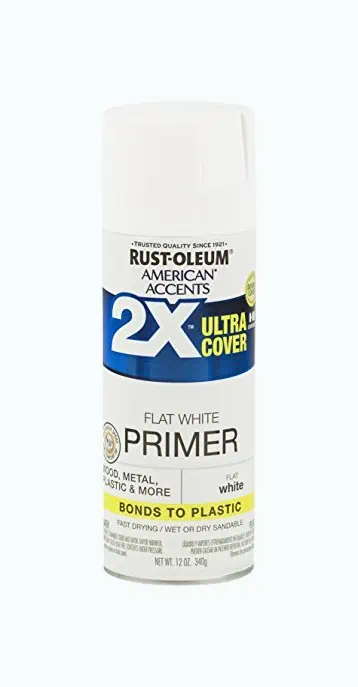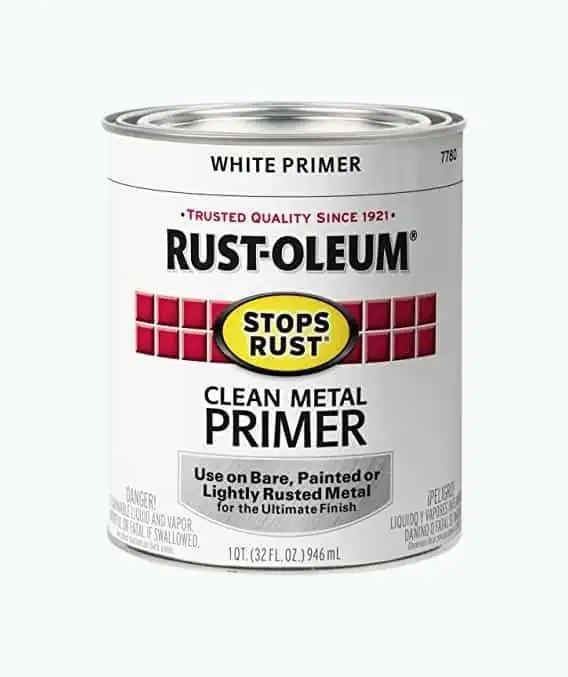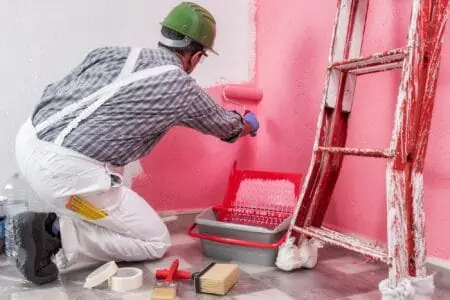Priming your bare surfaces makes the paint adhere better, seals it against damage, and takes less paint to achieve the same great results. Primer contains more resin than paint pigments compared to paint, which is why it works well as a base layer.
We scoured the internet searching for the 5 best paint primers, gauging them on their coverage and value for money to bring you our definitive list.

- Dries in just 20 minutes
- Twice the coverage of similar products
- Comfort-grip trigger for reduced fatigue

- Water-based, so better for the environment
- Coverage of 300 to 400 square feet
- Suitable for indoor and outdoor applications

- Extremely low vocs at just 5 grams per liter
- Primes, seals, and blocks stains
- Has a mildewcide to combat mold

- Suitable for bare, painted, and lightly rusted surfaces
- Enamel primer dries rock hard
- Recoats in 2 to 4 hours

- Covers almost every surface
- Contains a rust inhibitor
- No need to sand to get the paint to adhere
Review Methodology: At Sensible Digs, we take pride in our hands-on approach to assessing products, using stringent criteria and professional expertise to ensure accurate results. Our analysis of the best paint primers is based on solid data, performance checks, and first-hand experience. We compare and rank products according to key factors like coverage, durability, and drying time. Our reviews are backed by factual evidence, highlighting what sets each primer apart from its competitors. We evaluate the design choices of these primers and the impact they have on user experience. Our aim is to help you make informed decisions, backed by our thorough research and testing.
The Best Paint Primers of 2024
Trying to narrow down the best primer paint is tricky, but with hours of research, gauging the opinions of the public, and comparing like for like, we have our top 5 products.
Rust-Oleum American Accents Spray Primer
Best Paint Primer for Plastic
This spray primer is suitable for indoor and outdoor use. It dries in a matte finish in just 20 minutes, and you get 12 square feet of coverage. It adheres to wood, plastic, metal, and unglazed ceramic, so it is a versatile spray primer.
It’s also easy to use and store. Simply pop the lid back on, and it sits on the shelf until you next need it. Rust-Oleum claims that this primer delivers twice the coverage of similar products. They even give you a comfort-grip trigger to reduce finger fatigue.
The only downside with this primer is it only covers small areas, so if you are respraying a chair or plastic components, that’s fine, but not if you want to undertake a significant project.
Also, spray applicators are not as accurate as brushing, so you might get some wastage through overspray.
Pros
- Simple to use and easy to store.
- Twice the coverage of similar products.
- Comfort-grip trigger for reduced fatigue.
- Dries in just 20 minutes.
Cons
- Only suitable for small projects.
- Lacks accuracy, increasing overspray wastage.
Product Specs
| Quantity | 12 ounces |
| Application | Spray |
| Drying time | 20 minutes |
| Coverage | 12 square feet |
| Type | Oil-based |
Our Ratings
User Experience
INSL Stix Acrylic Bonding Primer
Best Paint Primer for Drywall
Drywall is extremely porous, so sealing the surface makes the top layer of paint adhere better. While this product covers drywall, it also works on metal, wood, ceramics, PVC, and masonry walls.
It is a water-based product, so it is kinder to the environment, and it has low VOCs, meaning there are no health implications when using this primer. It also has low odors, so you can use it in areas with limited ventilation.
You can also clean up with soap and water. You get 300 to 400 square feet of coverage, depending on the porosity of the surface, and it even cures in temperatures as low as 35 degrees Fahrenheit.
Once down, it dries ready for recoats in just 3 hours, and once you’ve finished priming your drywall, you can take it outside into the garden and prime your deck or furniture.
However, many customers have complained that this primer is too thin, so you are forced to lay down 2 or 3 coats to get a smooth finish.
Pros
- Water-based, so better for the environment.
- Coverage of 300 to 400 square feet.
- Recoats in just 3 hours.
- Suitable for indoor and outdoor applications.
Cons
- Thin formula means you need to apply 2 or 3 coats.
Product Specs
| Quantity | 1-gallon |
| Application | Brush, roller, or sprayer |
| Drying time | 3 hours |
| Coverage | 300 to 400 square feet |
| Type | Water-based |
Our Ratings
Personal Perspective
KILZ Premium High-Hide Stain Blocking Latex Primer
Best Paint Primer for Wood
This KILZ Premium is a primer, sealer, and stain blocker in one. It hides stains, covers almost every paint color, and adheres to most exterior and interior surfaces.
You get 300 to 400 square feet of coverage, and it dries ready for a second coat in under an hour. Curing takes 24 hours, and because it is water-based, you get extremely low odors and a VOC level of just 5 grams per liter.
Because it is water-based, it is kinder to the environment, and you can wash everything clean with soap and water. It even features a mildewcide to combat mold growth, so it is suitable in damper locations like kitchens and bathrooms.
One slight negative is the number of coats you need to apply. Some customers have complained they needed 2 or 3 layers before they got a smooth and solid surface to hide any previous colors from showing through.
Pros
- Extremely low VOCs at just 5 grams per liter.
- Primes, seals, and blocks stains.
- Recoats in 1-hour for speedy tasks.
- Has a mildewcide to combat mold.
Cons
- Thin formula requires 2 or 3 coats.
Product Specs
| Quantity | 1-gallon |
| Application | Brush, roller, or sprayer |
| Drying time | 1 hour |
| Coverage | 300 to 400 square feet |
| Type | Water-based |
Our Ratings
Community Feedback
Rust-Oleum Protective Enamel Paint Metal Primer
Best Metal Paint Primer
This Rust-Oleum primer is the ideal product to use if you have bare, painted, or lightly rusted metal. It’s an oil-based formula, so it has excellent rust-preventing capabilities.
It dries to the touch in 2 to 4 hours and covers up to 90 square feet. This primer is ideal for high-use environments, and because it is weather-resistant, it is suitable for indoor and outdoor use.
It is not suitable for bare galvanized metal, and because it is an enamel primer, it has limited coverage. It is also not ideal for large projects. However, it adheres to wood, metal masonry, and concrete, so it is versatile.
The other consideration is its impact on the environment. Oil-based formulas are damaging, polluting rivers and streams and impacting ecosystems. And you need mineral spirits to clean up afterward.
Pros
- Suitable for bare, painted, and lightly rusted surfaces.
- Enamel primer dries rock hard.
- Recoats in 2 to 4 hours.
- Suitable for indoor and outdoor use.
Cons
- Doesn’t adhere to galvanized metal.
- Damaging to the environment.
Product Specs
| Quantity | 32 fluid ounces |
| Application | Brush |
| Drying time | 2 to 4 hours |
| Coverage | 90 square feet |
| Type | Oil-based |
Our Ratings
First-Hand Impression
Rust-Oleum Zinsser Bulls Eye 1-2-3 Primer
Best General Purpose Primer
Sometimes a primer needs to cater to many different tasks and surfaces. From metal to wood and lightly rusted surfaces to bare masonry, a general-purpose primer like this Rust-Oleum is handy to keep in the house.
It comes in 1-quart tins and covers 100 square feet. It dries in 1-hour, so getting a second coat down and finishing the project in one day is possible, and because it’s water-based, it cleans with soap and water. This primer is also kinder to the environment.
This Bulls Eye primer sticks to most surfaces without the need to sand, and it contains a rust inhibitor, making it suitable for most metal surfaces. It even coats new concrete.
On the downside, several customers have complained that the cans arrived dented, and some say the formula is so thick, it leaves brush marks.
Pros
- Covers almost every surface.
- Contains a rust inhibitor.
- No need to sand to get the paint to adhere.
- Water-based and dries in 1-hour.
Cons
- Poor packaging leaves the cans dented.
- Super-thick formula leaves brush marks.
Product Specs
| Quantity | 1-quart |
| Application | Brush |
| Drying time | 1-hour |
| Coverage | 100 square feet |
| Type | Water-based |
Our Ratings
User Experience
| Product | Best | Quantity | Application | Drying time | Coverage | Type |
|---|---|---|---|---|---|---|
| Rust-Oleum American Accents Spray Primer | Best for Plastic | 12 ounces | Spray | 20 minutes | 12 square feet | Oil-based |
| INSL Stix Acrylic Bonding Primer | Best for Drywall | 1-gallon | Brush, roller, or sprayer | 3 hours | 300 – 400 square feet | Water-based |
| KILZ Premium High-Hide Stain Blocking Latex Primer | Best for Wood | 1-gallon | Brush, roller, or sprayer | 1 hour | 300 – 400 square feet | Water-based |
| Rust-Oleum Protective Enamel Paint Metal Primer | Best for Metal | 32 fluid ounces | Brush | 2 – 4 hours | 90 square feet | Oil-based |
| Rust-Oleum Zinsser Bulls Eye 1-2-3 Primer | Best General Purpose | 1-quart | Brush | 1-hour | 100 square feet | Water-based |
How To Choose the Best Paint Primer
What are the most important factors when choosing the best paint primer? Is it the price or the coverage? How about ease of application? We answer these questions and many more.


















